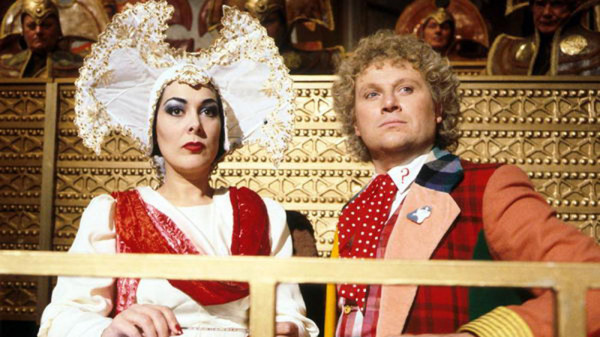It’s become a bit of a cliché to talk about wobbly sets and dodgy effects when referring to the classic era of Doctor Who – and there’s nothing else more likely to get your diehard fan riled up.
Without for one minute suggesting that the original 26-year run lacked any cheap-looking effects at all, it also had its fair share of triumphs.
So here, for your applause and general amazement are our Top 5 special effects in the classic series…
5. The Trial Ship (‘The Trial of a Time Lord’, 1986)
You probably guessed this one would be here, didn’t you? The opening to Season 23 is an extraordinary effect that still looks good today. The model of the Time Lord ship is incredibly detailed, meaning that as the camera swoops around it never once looks like a cheap model, but rather a genuinely massive object floating through space. As the TARDIS appears and is dragged towards it, surely this must herald the greatest Doctor Who story of them all? Oh well…
4. Fixing the Cyberman (‘Earthshock’, 1982)
I assume the answer is probably ‘With some clever editing, you idiot!’ but even to this day I don’t really know quite how they did this one. As the revived Cybermen advance towards the bridge of the freighter, the Doctor works some jiggery-pokery (what in the 1970s we would have probably called reversing the polarity) with the ship’s anti-matter container, allowing him to fill the doorway with a solid door just as a Cyberman is coming through it… It looks utterly realistic, presumably due to Peter Grimwade’s fast pacing, but perhaps also because we don’t even realise an effects shot has happened until suddenly, a moment after seeing it, we find ourselves thinking, ‘Hang on…?’
3. Blowing Up the Church (‘The Daemons’, 1971)
[Watch from 18:50]
Simple but effective, this model explosion effect was the subject of several letters to the BBC, complaining that a quaint old English Church had been blown up simply to make a TV programme. You may argue that this is a sign of how very innocent TV viewers were in the 1970s; I’d argue that it’s a sign of just how convincing this effect is. (And for an encore the same team went on to blow up Sir Reginald Styles’ Auderley House in ‘Day of the Daleks’ the following year!)
2. A Dalek going upstairs (‘Remembrance of the Daleks’, 1988)
They’ve perfected it since 2005, I’ll grant you, but I was never really sold on the effect of the Dalek floating up the stairwell in ‘Dalek’, it just looks a little too ‘flat’ to convince me. So on this occasion I’d say the classic series not only did it first, but did it better. Without the CGI option, in 1988 the only way to realise the part one cliffhanger of a Dalek pursuing the Doctor up some cellar stairs was to actually move a real Dalek prop up the stairs! Add in some shiny effects around the base so that you can’t see the pole and the stagehands that are doing all the hard work, and it’s a totally convincing moment in which we finally get to see a Dalek go where no Dalek has gone before.
1. The First Regeneration (‘The Tenth Planet’, 1966)
Let’s put this one in context. Pertwee changing into Baker in ‘Planet of the Spiders’ is such a poor effect that it’s almost as if they’d forgotten about it until five minutes before the end of the studio day. 1996’s McCoy into McGann has the advantage of computer technology, but has the disadvantage of the director apparently instructing them to gurn their way through it. And even the most recent change from Smith to Capaldi was a ‘blink and you’ve missed it’ affair which has left many a fan feeling a little short-changed.
So with all that in mind it makes the original transformation, recorded forty-eight years ago, all the more extraordinary. Even today it’s almost impossible to ‘see the join’ and pinpoint the moment where it’s suddenly Troughton rather than Hartnell. Legend has it that the sequence took the whole day to get right, but it was certainly worth it – that single moment needed to totally sell the idea to the viewing audience, it could not get away with looking second-rate or also-ran. And it doesn’t disappoint. I don’t know how many times I’ve watched this now, still I find myself convinced that this extraordinary old man has changed his appearance right before my very eyes.
What’s your favourite special effect in classic Doctor Who? Let us know below…

